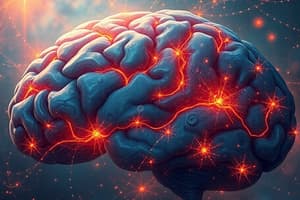Podcast
Questions and Answers
What is the primary function of the sensory register in the multi-store model of memory?
What is the primary function of the sensory register in the multi-store model of memory?
- To process information through attention
- To store information in the form of sound
- To directly receive sensory information from the five main senses (correct)
- To store information for a long duration
What is the approximate duration of information in the short-term memory?
What is the approximate duration of information in the short-term memory?
- 1-2 minutes
- 18-30 seconds (correct)
- 250 milliseconds
- Unlimited duration
How does information move from the sensory register to short-term memory?
How does information move from the sensory register to short-term memory?
- Through attention (correct)
- Through displacement
- Through rehearsal
- Through semantic coding
What is the capacity of short-term memory?
What is the capacity of short-term memory?
How is information stored in long-term memory?
How is information stored in long-term memory?
What happens to information that is not paid attention to in the multi-store model of memory?
What happens to information that is not paid attention to in the multi-store model of memory?
What is the primacy-recency effect an example of in the context of memory?
What is the primacy-recency effect an example of in the context of memory?
What was demonstrated by Sperling's study?
What was demonstrated by Sperling's study?
What is the typical range of recall for short-term memory?
What is the typical range of recall for short-term memory?
What is the main criticism of the multi-store model of memory?
What is the main criticism of the multi-store model of memory?
What is the duration of short-term memory, as demonstrated by Peterson and Peterson's study?
What is the duration of short-term memory, as demonstrated by Peterson and Peterson's study?
What is the main advantage of chunking, according to Miller's research?
What is the main advantage of chunking, according to Miller's research?
Flashcards are hidden until you start studying
Study Notes
• The multi-store model of memory is an information processing model created by researchers Atkinson and Shiffrin in 1968, which consists of three stores: sensory register, short-term memory, and long-term memory.
• The sensory register is the first store that directly receives sensory information from the five main senses, and it has a modality-specific coding, meaning it depends on the sense organ.
• The capacity of the sensory register is very large, possibly unlimited, and it has a very short duration of around 250 milliseconds before information is lost.
• Information moves from the sensory register to short-term memory through attention, and any information not paid attention to is lost.
• Short-term memory has an acoustic coding, meaning information is stored in the form of sound, and it has a duration of between 18 and 30 seconds before information is lost if not maintained by subvocal repetition.
• The capacity of short-term memory is 7 items plus or minus two, and information can be passed to long-term memory through rehearsal, either maintenance rehearsal or elaborative rehearsal.
• Long-term memory has a semantic coding, meaning information is stored as part of a set of meaningful connections to other stored information, and it has a very large capacity and duration, potentially unlimited.
• The multi-store model suggests that information is lost from short-term memory due to displacement or decay, but it may not be truly lost, and could be recalled with the right cue.
• Research evidence for the multi-store model includes the primacy-recency effect, which shows that long-term and short-term memory are separate processes.
• Glanzer's study (1966) demonstrated the primacy-recency effect, where participants tended to remember the first and last words in a list, but struggled to remember the middle words.
• Sperling's study (1966) showed that the sensory register has a much larger capacity than short-term memory, as participants were able to accurately recall a full row of letters flashed on a screen for a short time.
• Baddeley's study demonstrated the coding of both long-term and short-term memory, showing that short-term memory is coded acoustically and long-term memory is coded semantically.- Organizing a storage system in a certain way can make it more difficult to recall individual items if all the items are similar.
- The capacity of short-term memory is small, with an average recall of 9 numbers and 7 letters, with a range of plus or minus two.
- Miller's research shows that chunking, or making small sets or groups of items, can increase the capacity of short-term memory.
- The duration of short-term memory is between 18 and 30 seconds, as demonstrated by Peterson and Peterson's study using trigrams and interference tasks.
- The capacity and duration of long-term memory are potentially unlimited, but at least very large, as shown by studies such as Wagnaar's diary experiment and Bahrick's old photograph recall study.
- Wagnaar's study found a 75% recall after 1 year and 45% after 5 years of diary entries.
- Bahrick's study found a 90% recall after 15 years and 80% after 48 years of old photographs.
- The multi-store model of memory has been criticized for its artificial testing methods, lacking ecological validity and mundane realism.
- The model's simplicity has also been criticized, suggesting that short-term memory and long-term memory are not unitary and passive stores.
- Research has shown that there are multiple types of long-term memory and that short-term memory has active components that work together.
- The capacity of short-term memory is not fixed and can change over a lifetime with practice.
- The multi-store model lacks face validity, as it does not account for long-term memories that are tastes and smells.
Studying That Suits You
Use AI to generate personalized quizzes and flashcards to suit your learning preferences.




